Petrol Price Analysis & Statistical Modelling: BUS708 Assignment
VerifiedAdded on 2023/04/04
|8
|1867
|332
Report
AI Summary
This report provides an analysis of petrol prices in Australia, utilizing data from government sources and a survey of KOI students. The analysis includes statistical modeling to identify trends and variability in petrol prices, with a focus on supporting NRMA's media reporting. Key findings include the average petrol price, price variations across different brands (7-Eleven, Caltex, Caltex Woolworths, and Coles Express), and student preferences for service stations. Hypothesis testing and ANOVA are used to determine the significance of price differences. The report concludes with suggestions for further research, emphasizing the importance of understanding factors affecting petrol price fluctuations to ensure affordability and availability for Australian citizens and industries. Desklib offers a range of similar reports and solved assignments for students.

1
STATISTICS AND DATA ANALYSIS
by Student’s Name
Code + Name of Course
Professor’s Name
University
City (State)
Date
STATISTICS AND DATA ANALYSIS
by Student’s Name
Code + Name of Course
Professor’s Name
University
City (State)
Date
Paraphrase This Document
Need a fresh take? Get an instant paraphrase of this document with our AI Paraphraser

2
1. Section 1: Introduction
a. Statistical modelling is an approach in data analysis that assist researchers discover certain
information regarding a phenomenon that is assumed to be in existence. Through modelling
of statistics, one is capable of identifying trends and analysing variability that exist in a data
set (Friendly & Meyer, 2016). Modelling in statistics is a unifying strategy that combines
both the estimation and hypothesis testing. Estimation allows for generalization of certain
findings from a sample data to the entire population on the other hand hypothesis testing is
applied to determine the complexity of the statistical model. Statistical modelling does assist
in prediction. Prediction entails evaluating how changes in a particular data set affect the
output of another. In addition to the prediction, modelling also allows a researcher to
provide explanations on the relationship between variables.
In this report the aim is to analyse the service station history prices so as to support the
activities of the NRMA. NRMA is an agency that is responsible for giving media reports to the
public with regard to current trends in the petrol prices (Kroese & Chan, 2014). For the
agency to provide relevant and accurate information, there is need for the historic data to
be analysed and trends evaluated. Microsoft excel will be applied in breaking down the past
data sets and conclusions drawn.
b. Dataset 1
The data set 1 is a subset of service station and price history data that is availed by the
government of Australia. Petroleum is one of the products that is massively consumed by
the Australians, for this reason the government has the responsibility of controlling its
supply so as to ensure the activities in the economy are not disrupted by shortages. One of
the ways of influencing the petroleum service industry is by providing the citizens of the
nation with periodic information regarding the occurrences taking place in the industry. By
definition secondary data is data that has been collected by someone other than the current
user. The data set 1 having been collected by the Australian government is treated as
secondary data. Some of the variables involved in the data are price of petrol and brand of
service station. To collect the data, the government might have applied questionaries to
interview the public or just used past records stored by some of the largest stakeholders in
the industry.
c. Dataset 2
Dataset 2 was collected from a sample of 50 KOI students. The data having been collected
by the person undertaking the research is treated as primary data. The research is meant for
analysing the trends in the Australian petrol industry, it was thus not possible to raise the
necessary capital to collect adequate data to meet the right sample size requirements.
Another limitation of the study is that the sample space was restricted to students and
hence the research failed to take into account the views of other citizens of the nation. The
variable in the dataset was service stations in Australia
2. Section 2: Analysis of single variable in Dataset 1
a. The table below gives a summary of the distribution of the petrol prices in Australia.
1. Section 1: Introduction
a. Statistical modelling is an approach in data analysis that assist researchers discover certain
information regarding a phenomenon that is assumed to be in existence. Through modelling
of statistics, one is capable of identifying trends and analysing variability that exist in a data
set (Friendly & Meyer, 2016). Modelling in statistics is a unifying strategy that combines
both the estimation and hypothesis testing. Estimation allows for generalization of certain
findings from a sample data to the entire population on the other hand hypothesis testing is
applied to determine the complexity of the statistical model. Statistical modelling does assist
in prediction. Prediction entails evaluating how changes in a particular data set affect the
output of another. In addition to the prediction, modelling also allows a researcher to
provide explanations on the relationship between variables.
In this report the aim is to analyse the service station history prices so as to support the
activities of the NRMA. NRMA is an agency that is responsible for giving media reports to the
public with regard to current trends in the petrol prices (Kroese & Chan, 2014). For the
agency to provide relevant and accurate information, there is need for the historic data to
be analysed and trends evaluated. Microsoft excel will be applied in breaking down the past
data sets and conclusions drawn.
b. Dataset 1
The data set 1 is a subset of service station and price history data that is availed by the
government of Australia. Petroleum is one of the products that is massively consumed by
the Australians, for this reason the government has the responsibility of controlling its
supply so as to ensure the activities in the economy are not disrupted by shortages. One of
the ways of influencing the petroleum service industry is by providing the citizens of the
nation with periodic information regarding the occurrences taking place in the industry. By
definition secondary data is data that has been collected by someone other than the current
user. The data set 1 having been collected by the Australian government is treated as
secondary data. Some of the variables involved in the data are price of petrol and brand of
service station. To collect the data, the government might have applied questionaries to
interview the public or just used past records stored by some of the largest stakeholders in
the industry.
c. Dataset 2
Dataset 2 was collected from a sample of 50 KOI students. The data having been collected
by the person undertaking the research is treated as primary data. The research is meant for
analysing the trends in the Australian petrol industry, it was thus not possible to raise the
necessary capital to collect adequate data to meet the right sample size requirements.
Another limitation of the study is that the sample space was restricted to students and
hence the research failed to take into account the views of other citizens of the nation. The
variable in the dataset was service stations in Australia
2. Section 2: Analysis of single variable in Dataset 1
a. The table below gives a summary of the distribution of the petrol prices in Australia.

3
Price
Mean 123.06
Standard Error 0.43
Median 123.4
Mode 127.9
Standard Deviation 13.46
Sample Variance 181.11
Kurtosis 2.14
Skewness -0.55
Range 99.6
Minimum 55.9
Maximum 155.5
Sum 123057.8
Count 1000
Largest(1) 155.5
Smallest(1) 55.9
The mean price is 123.06 with the mode being 127.9 and median 123.4. All the three
measures of central tendency are close values which indicates that the data is less skewed.
The standard deviation is 13.46. The skewness of just -0.5 shows that only a few of the
variables do fall below the mean.
The figure below is a histogram of the data set.
The histogram is bimodal and bell shaped which can be interpreted as the data is normally
distributed, the lognormal distributed can best be applied in describing the distribution of
the data
b. Hypothesis testing
Hypothesis testing involves 5 general steps the first one is stating the null and alternative
hypothesis.
H0 : μ=115
H1 : μ> 115
Price
Mean 123.06
Standard Error 0.43
Median 123.4
Mode 127.9
Standard Deviation 13.46
Sample Variance 181.11
Kurtosis 2.14
Skewness -0.55
Range 99.6
Minimum 55.9
Maximum 155.5
Sum 123057.8
Count 1000
Largest(1) 155.5
Smallest(1) 55.9
The mean price is 123.06 with the mode being 127.9 and median 123.4. All the three
measures of central tendency are close values which indicates that the data is less skewed.
The standard deviation is 13.46. The skewness of just -0.5 shows that only a few of the
variables do fall below the mean.
The figure below is a histogram of the data set.
The histogram is bimodal and bell shaped which can be interpreted as the data is normally
distributed, the lognormal distributed can best be applied in describing the distribution of
the data
b. Hypothesis testing
Hypothesis testing involves 5 general steps the first one is stating the null and alternative
hypothesis.
H0 : μ=115
H1 : μ> 115
⊘ This is a preview!⊘
Do you want full access?
Subscribe today to unlock all pages.

Trusted by 1+ million students worldwide
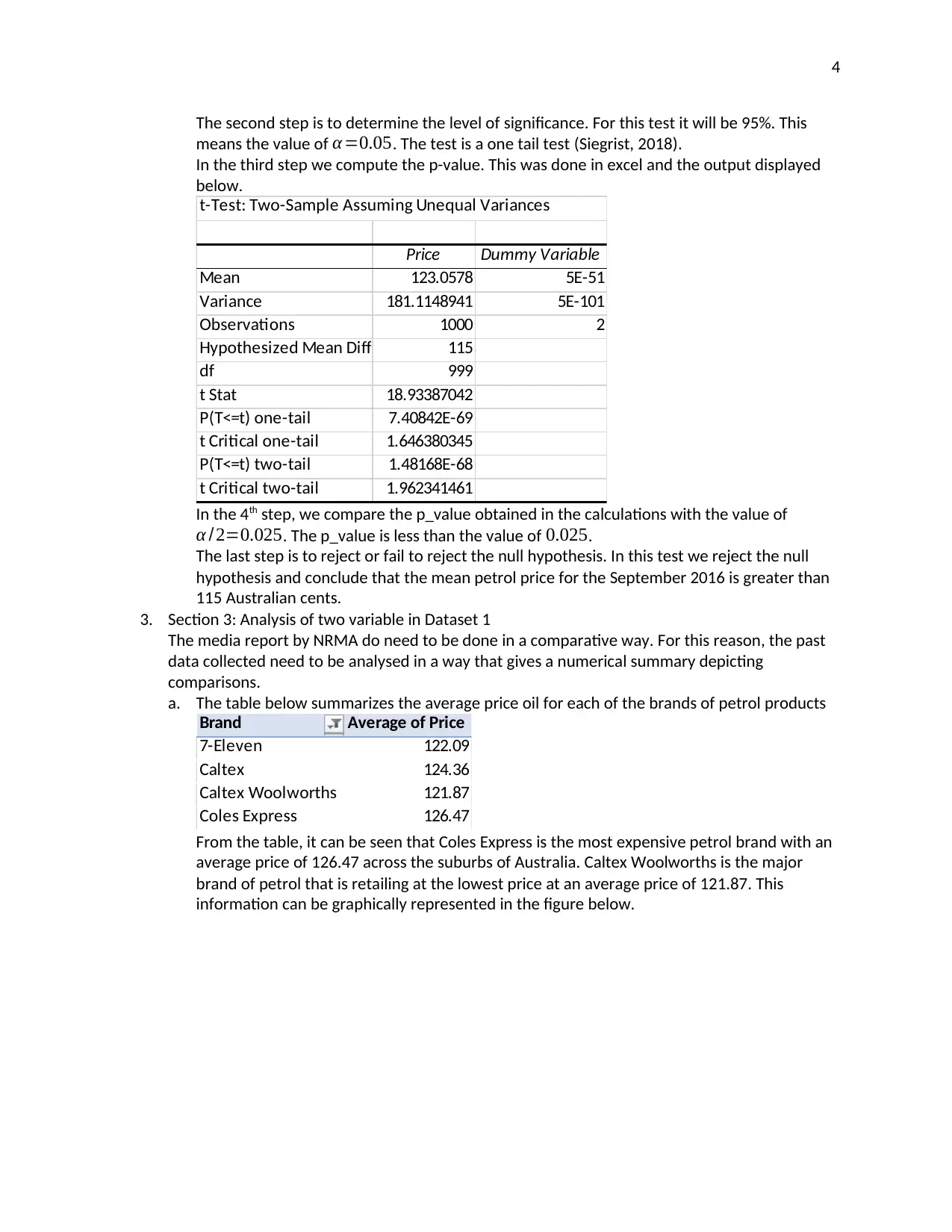
4
The second step is to determine the level of significance. For this test it will be 95%. This
means the value of α=0.05. The test is a one tail test (Siegrist, 2018).
In the third step we compute the p-value. This was done in excel and the output displayed
below.
t-Test: Two-Sample Assuming Unequal Variances
Price Dummy Variable
Mean 123.0578 5E-51
Variance 181.1148941 5E-101
Observations 1000 2
Hypothesized Mean Difference 115
df 999
t Stat 18.93387042
P(T<=t) one-tail 7.40842E-69
t Critical one-tail 1.646380345
P(T<=t) two-tail 1.48168E-68
t Critical two-tail 1.962341461
In the 4th step, we compare the p_value obtained in the calculations with the value of
α / 2=0.025. The p_value is less than the value of 0.025.
The last step is to reject or fail to reject the null hypothesis. In this test we reject the null
hypothesis and conclude that the mean petrol price for the September 2016 is greater than
115 Australian cents.
3. Section 3: Analysis of two variable in Dataset 1
The media report by NRMA do need to be done in a comparative way. For this reason, the past
data collected need to be analysed in a way that gives a numerical summary depicting
comparisons.
a. The table below summarizes the average price oil for each of the brands of petrol products
Brand Average of Price
7-Eleven 122.09
Caltex 124.36
Caltex Woolworths 121.87
Coles Express 126.47
From the table, it can be seen that Coles Express is the most expensive petrol brand with an
average price of 126.47 across the suburbs of Australia. Caltex Woolworths is the major
brand of petrol that is retailing at the lowest price at an average price of 121.87. This
information can be graphically represented in the figure below.
The second step is to determine the level of significance. For this test it will be 95%. This
means the value of α=0.05. The test is a one tail test (Siegrist, 2018).
In the third step we compute the p-value. This was done in excel and the output displayed
below.
t-Test: Two-Sample Assuming Unequal Variances
Price Dummy Variable
Mean 123.0578 5E-51
Variance 181.1148941 5E-101
Observations 1000 2
Hypothesized Mean Difference 115
df 999
t Stat 18.93387042
P(T<=t) one-tail 7.40842E-69
t Critical one-tail 1.646380345
P(T<=t) two-tail 1.48168E-68
t Critical two-tail 1.962341461
In the 4th step, we compare the p_value obtained in the calculations with the value of
α / 2=0.025. The p_value is less than the value of 0.025.
The last step is to reject or fail to reject the null hypothesis. In this test we reject the null
hypothesis and conclude that the mean petrol price for the September 2016 is greater than
115 Australian cents.
3. Section 3: Analysis of two variable in Dataset 1
The media report by NRMA do need to be done in a comparative way. For this reason, the past
data collected need to be analysed in a way that gives a numerical summary depicting
comparisons.
a. The table below summarizes the average price oil for each of the brands of petrol products
Brand Average of Price
7-Eleven 122.09
Caltex 124.36
Caltex Woolworths 121.87
Coles Express 126.47
From the table, it can be seen that Coles Express is the most expensive petrol brand with an
average price of 126.47 across the suburbs of Australia. Caltex Woolworths is the major
brand of petrol that is retailing at the lowest price at an average price of 121.87. This
information can be graphically represented in the figure below.
Paraphrase This Document
Need a fresh take? Get an instant paraphrase of this document with our AI Paraphraser
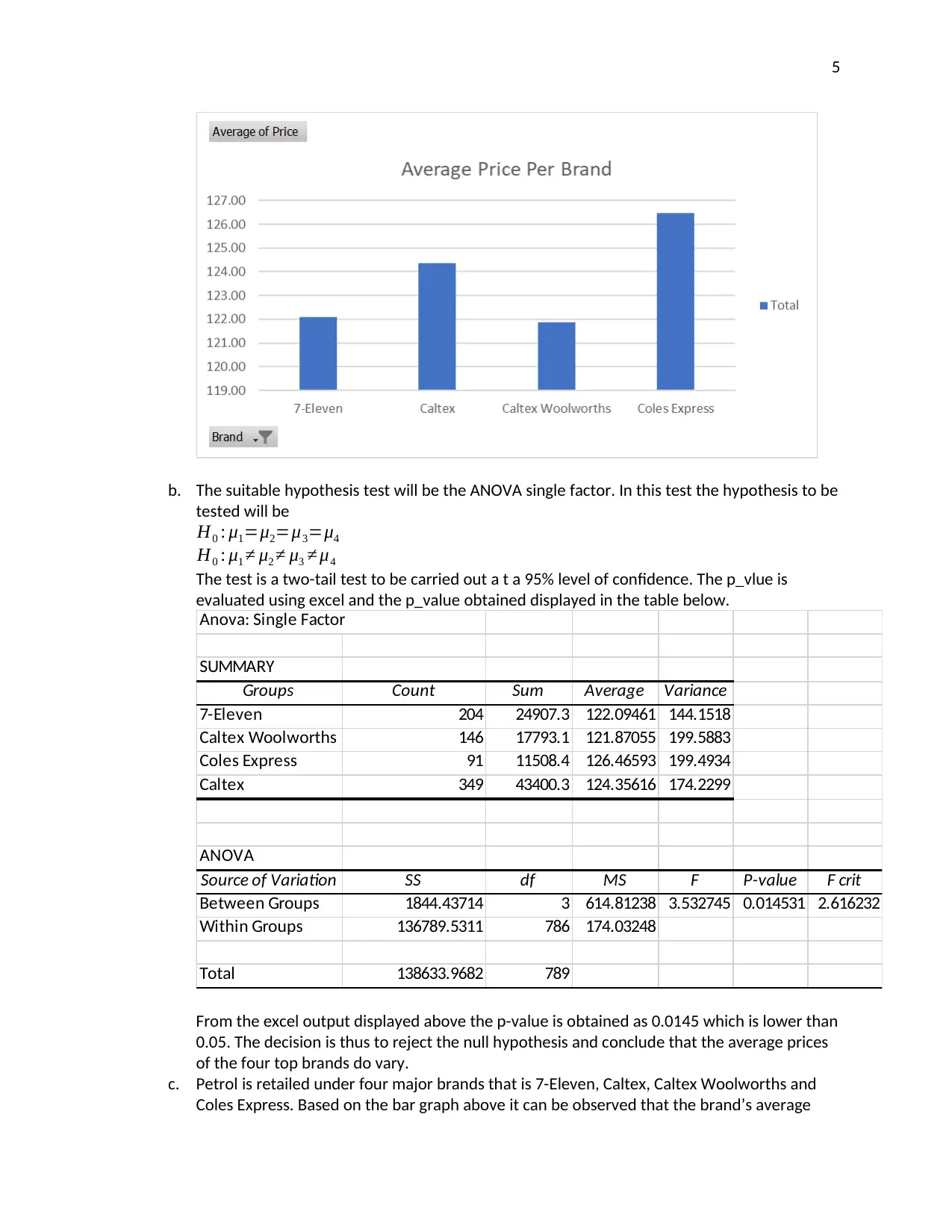
5
b. The suitable hypothesis test will be the ANOVA single factor. In this test the hypothesis to be
tested will be
H0 : μ1=μ2=μ3=μ4
H0 : μ1 ≠ μ2 ≠ μ3 ≠ μ4
The test is a two-tail test to be carried out a t a 95% level of confidence. The p_vlue is
evaluated using excel and the p_value obtained displayed in the table below.
Anova: Single Factor
SUMMARY
Groups Count Sum Average Variance
7-Eleven 204 24907.3 122.09461 144.1518
Caltex Woolworths 146 17793.1 121.87055 199.5883
Coles Express 91 11508.4 126.46593 199.4934
Caltex 349 43400.3 124.35616 174.2299
ANOVA
Source of Variation SS df MS F P-value F crit
Between Groups 1844.43714 3 614.81238 3.532745 0.014531 2.616232
Within Groups 136789.5311 786 174.03248
Total 138633.9682 789
From the excel output displayed above the p-value is obtained as 0.0145 which is lower than
0.05. The decision is thus to reject the null hypothesis and conclude that the average prices
of the four top brands do vary.
c. Petrol is retailed under four major brands that is 7-Eleven, Caltex, Caltex Woolworths and
Coles Express. Based on the bar graph above it can be observed that the brand’s average
b. The suitable hypothesis test will be the ANOVA single factor. In this test the hypothesis to be
tested will be
H0 : μ1=μ2=μ3=μ4
H0 : μ1 ≠ μ2 ≠ μ3 ≠ μ4
The test is a two-tail test to be carried out a t a 95% level of confidence. The p_vlue is
evaluated using excel and the p_value obtained displayed in the table below.
Anova: Single Factor
SUMMARY
Groups Count Sum Average Variance
7-Eleven 204 24907.3 122.09461 144.1518
Caltex Woolworths 146 17793.1 121.87055 199.5883
Coles Express 91 11508.4 126.46593 199.4934
Caltex 349 43400.3 124.35616 174.2299
ANOVA
Source of Variation SS df MS F P-value F crit
Between Groups 1844.43714 3 614.81238 3.532745 0.014531 2.616232
Within Groups 136789.5311 786 174.03248
Total 138633.9682 789
From the excel output displayed above the p-value is obtained as 0.0145 which is lower than
0.05. The decision is thus to reject the null hypothesis and conclude that the average prices
of the four top brands do vary.
c. Petrol is retailed under four major brands that is 7-Eleven, Caltex, Caltex Woolworths and
Coles Express. Based on the bar graph above it can be observed that the brand’s average
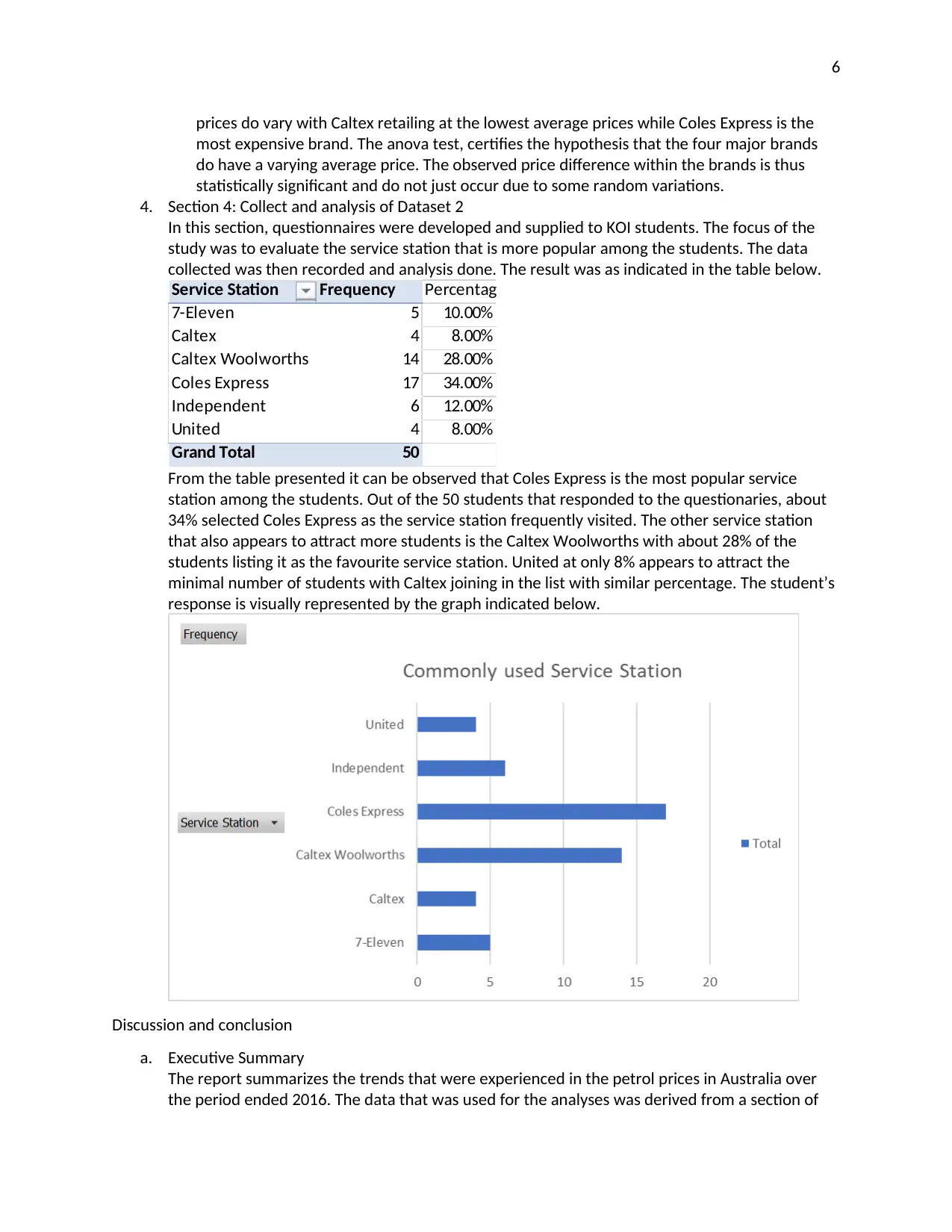
6
prices do vary with Caltex retailing at the lowest average prices while Coles Express is the
most expensive brand. The anova test, certifies the hypothesis that the four major brands
do have a varying average price. The observed price difference within the brands is thus
statistically significant and do not just occur due to some random variations.
4. Section 4: Collect and analysis of Dataset 2
In this section, questionnaires were developed and supplied to KOI students. The focus of the
study was to evaluate the service station that is more popular among the students. The data
collected was then recorded and analysis done. The result was as indicated in the table below.
Service Station Frequency Percentage
7-Eleven 5 10.00%
Caltex 4 8.00%
Caltex Woolworths 14 28.00%
Coles Express 17 34.00%
Independent 6 12.00%
United 4 8.00%
Grand Total 50
From the table presented it can be observed that Coles Express is the most popular service
station among the students. Out of the 50 students that responded to the questionaries, about
34% selected Coles Express as the service station frequently visited. The other service station
that also appears to attract more students is the Caltex Woolworths with about 28% of the
students listing it as the favourite service station. United at only 8% appears to attract the
minimal number of students with Caltex joining in the list with similar percentage. The student’s
response is visually represented by the graph indicated below.
Discussion and conclusion
a. Executive Summary
The report summarizes the trends that were experienced in the petrol prices in Australia over
the period ended 2016. The data that was used for the analyses was derived from a section of
prices do vary with Caltex retailing at the lowest average prices while Coles Express is the
most expensive brand. The anova test, certifies the hypothesis that the four major brands
do have a varying average price. The observed price difference within the brands is thus
statistically significant and do not just occur due to some random variations.
4. Section 4: Collect and analysis of Dataset 2
In this section, questionnaires were developed and supplied to KOI students. The focus of the
study was to evaluate the service station that is more popular among the students. The data
collected was then recorded and analysis done. The result was as indicated in the table below.
Service Station Frequency Percentage
7-Eleven 5 10.00%
Caltex 4 8.00%
Caltex Woolworths 14 28.00%
Coles Express 17 34.00%
Independent 6 12.00%
United 4 8.00%
Grand Total 50
From the table presented it can be observed that Coles Express is the most popular service
station among the students. Out of the 50 students that responded to the questionaries, about
34% selected Coles Express as the service station frequently visited. The other service station
that also appears to attract more students is the Caltex Woolworths with about 28% of the
students listing it as the favourite service station. United at only 8% appears to attract the
minimal number of students with Caltex joining in the list with similar percentage. The student’s
response is visually represented by the graph indicated below.
Discussion and conclusion
a. Executive Summary
The report summarizes the trends that were experienced in the petrol prices in Australia over
the period ended 2016. The data that was used for the analyses was derived from a section of
⊘ This is a preview!⊘
Do you want full access?
Subscribe today to unlock all pages.

Trusted by 1+ million students worldwide
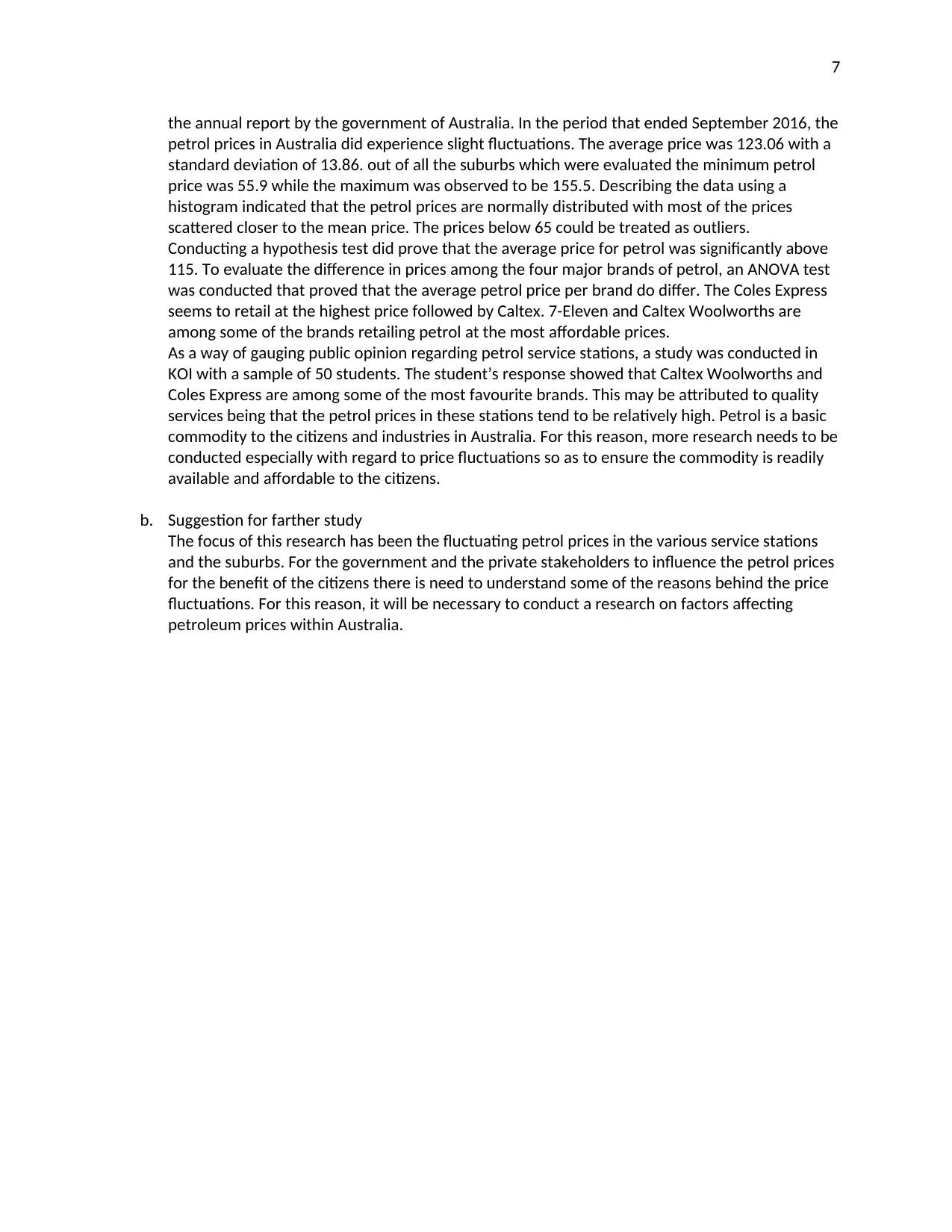
7
the annual report by the government of Australia. In the period that ended September 2016, the
petrol prices in Australia did experience slight fluctuations. The average price was 123.06 with a
standard deviation of 13.86. out of all the suburbs which were evaluated the minimum petrol
price was 55.9 while the maximum was observed to be 155.5. Describing the data using a
histogram indicated that the petrol prices are normally distributed with most of the prices
scattered closer to the mean price. The prices below 65 could be treated as outliers.
Conducting a hypothesis test did prove that the average price for petrol was significantly above
115. To evaluate the difference in prices among the four major brands of petrol, an ANOVA test
was conducted that proved that the average petrol price per brand do differ. The Coles Express
seems to retail at the highest price followed by Caltex. 7-Eleven and Caltex Woolworths are
among some of the brands retailing petrol at the most affordable prices.
As a way of gauging public opinion regarding petrol service stations, a study was conducted in
KOI with a sample of 50 students. The student’s response showed that Caltex Woolworths and
Coles Express are among some of the most favourite brands. This may be attributed to quality
services being that the petrol prices in these stations tend to be relatively high. Petrol is a basic
commodity to the citizens and industries in Australia. For this reason, more research needs to be
conducted especially with regard to price fluctuations so as to ensure the commodity is readily
available and affordable to the citizens.
b. Suggestion for farther study
The focus of this research has been the fluctuating petrol prices in the various service stations
and the suburbs. For the government and the private stakeholders to influence the petrol prices
for the benefit of the citizens there is need to understand some of the reasons behind the price
fluctuations. For this reason, it will be necessary to conduct a research on factors affecting
petroleum prices within Australia.
the annual report by the government of Australia. In the period that ended September 2016, the
petrol prices in Australia did experience slight fluctuations. The average price was 123.06 with a
standard deviation of 13.86. out of all the suburbs which were evaluated the minimum petrol
price was 55.9 while the maximum was observed to be 155.5. Describing the data using a
histogram indicated that the petrol prices are normally distributed with most of the prices
scattered closer to the mean price. The prices below 65 could be treated as outliers.
Conducting a hypothesis test did prove that the average price for petrol was significantly above
115. To evaluate the difference in prices among the four major brands of petrol, an ANOVA test
was conducted that proved that the average petrol price per brand do differ. The Coles Express
seems to retail at the highest price followed by Caltex. 7-Eleven and Caltex Woolworths are
among some of the brands retailing petrol at the most affordable prices.
As a way of gauging public opinion regarding petrol service stations, a study was conducted in
KOI with a sample of 50 students. The student’s response showed that Caltex Woolworths and
Coles Express are among some of the most favourite brands. This may be attributed to quality
services being that the petrol prices in these stations tend to be relatively high. Petrol is a basic
commodity to the citizens and industries in Australia. For this reason, more research needs to be
conducted especially with regard to price fluctuations so as to ensure the commodity is readily
available and affordable to the citizens.
b. Suggestion for farther study
The focus of this research has been the fluctuating petrol prices in the various service stations
and the suburbs. For the government and the private stakeholders to influence the petrol prices
for the benefit of the citizens there is need to understand some of the reasons behind the price
fluctuations. For this reason, it will be necessary to conduct a research on factors affecting
petroleum prices within Australia.
Paraphrase This Document
Need a fresh take? Get an instant paraphrase of this document with our AI Paraphraser
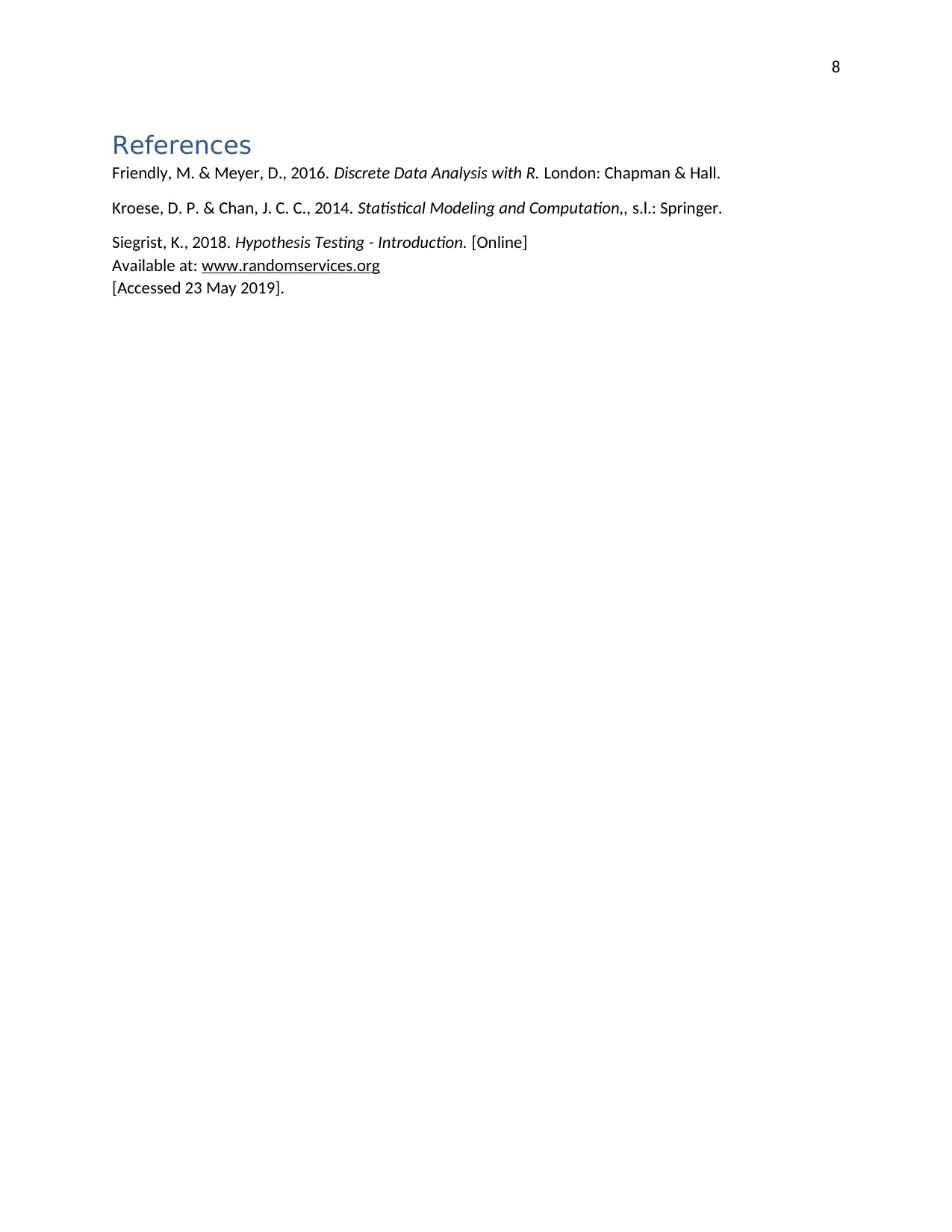
8
References
Friendly, M. & Meyer, D., 2016. Discrete Data Analysis with R. London: Chapman & Hall.
Kroese, D. P. & Chan, J. C. C., 2014. Statistical Modeling and Computation,, s.l.: Springer.
Siegrist, K., 2018. Hypothesis Testing - Introduction. [Online]
Available at: www.randomservices.org
[Accessed 23 May 2019].
References
Friendly, M. & Meyer, D., 2016. Discrete Data Analysis with R. London: Chapman & Hall.
Kroese, D. P. & Chan, J. C. C., 2014. Statistical Modeling and Computation,, s.l.: Springer.
Siegrist, K., 2018. Hypothesis Testing - Introduction. [Online]
Available at: www.randomservices.org
[Accessed 23 May 2019].
1 out of 8
Related Documents
Your All-in-One AI-Powered Toolkit for Academic Success.
+13062052269
info@desklib.com
Available 24*7 on WhatsApp / Email
![[object Object]](/_next/static/media/star-bottom.7253800d.svg)
Unlock your academic potential
Copyright © 2020–2025 A2Z Services. All Rights Reserved. Developed and managed by ZUCOL.





